
Shanghai cuisine, also known as Hu cuisine, is a popular style of Chinese food. In a narrow sense, Shanghai cuisine refers only to what is traditionally called Benbang cuisine which originated in Shanghai. In a broader sense, it refers to complex styles of cooking developed under the influence of neighboring Jiangsu and Zhejiang provinces.
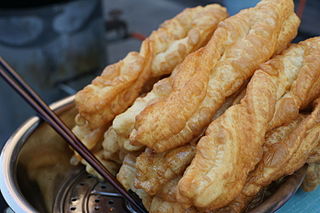
Youtiao, known in Southern China as Yu Char Kway is a long golden-brown deep-fried strip of wheat flour dough of Chinese origin and also popular in other East and Southeast Asian cuisines.

Popiah is a Fujianese/Teochew-style fresh spring roll filled with an assortment of fresh, dried, and cooked ingredients, eaten during the Qingming Festival and other celebratory occasions. The dish is made by the people and diaspora of Fujian province of Mainland China, neighbouring Chaoshan district, and by the Teochew and Hoklo diaspora in various regions throughout Southeast Asia and in Taiwan, The origin of popiah dates back to the 17th century.

Misua, also known as wheat vermicelli, is a very thin variety of salted noodles made from wheat flour. It originated in Fujian, China. The noodles differ from mifen and cellophane noodles in that those varieties are made from rice and mung beans, respectively.

Cellophane noodles, or fensi, sometimes called glass noodles, are a type of transparent noodle made from starch and water. A stabilizer such as chitosan may also be used.

Singaporean cuisine is derived from several ethnic groups in Singapore and has developed through centuries of political, economic, and social changes in the cosmopolitan city-state.
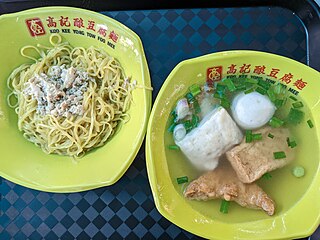
Yong tau foo is a Hakka Chinese dish consisting primarily of tofu filled with ground meat mixture or fish paste. Variation of this food include vegetables and mushrooms stuffed with ground meat or surimi. Yong tau foo is eaten in numerous ways, either dry with a sauce or served as a soup dish.

Tahu goreng or Tauhu goreng is a generic name for any type of fried tofu dish in the cuisines of Indonesia, Malaysia and Singapore.

Abura-age (油揚げ) is a Japanese food product made from twice-fried soybeans. It is produced by cutting tofu into thin slices and deep-frying them first at 110–120 °C, and then again at 180–200 °C. Abura-age is often used to wrap inari-zushi (稲荷寿司), and is added to miso soup. It is also added to udon noodle dishes, which are called kitsune-udon because of legends that foxes (kitsune) like deep-fried tofu. Abura-age can also be stuffed, e.g. with nattō, before frying again. There is a thicker variety known as atsu-age (厚揚げ) or nama-age (生揚げ).
The city of Ipoh is the administrative capital of the Malaysian state of Perak and is famous for its cuisine. Its food culture is driven by its majority Chinese population who are largely of Cantonese and Hakka descent. There is also Malay and Indian food in Ipoh; the nasi kandar served by a prominent local Mamak stall is nicknamed nasi ganja due to its supposed addictive properties. Specialty foods from neighbouring towns are also available in Ipoh.

Noodle soup refers to a variety of soups with noodles and other ingredients served in a light broth. Noodle soup is a common dish across East Asia, Southeast Asia and the Himalayan states of South Asia. Various types of noodles are used, such as rice noodles, wheat noodles and egg noodles.

Chinese Indonesian cuisine is characterized by the mixture of Chinese with local Indonesian style. Chinese Indonesians, mostly descendant of Han ethnic Hokkien and Hakka speakers, brought their legacy of Chinese cuisine, and modified some of the dishes with the addition of Indonesian ingredients, such as kecap manis, palm sugar, peanut sauce, chili, santan and local spices to form a hybrid Chinese-Indonesian cuisine. Some of the dishes and cakes share the same style as in Malaysia and Singapore, known as Nyonya cuisine by the Peranakan.

Mee pok is a Chinese noodle characterized by its flat and yellow appearance, varying in thickness and width. The dish is of Chaoshan origin and is commonly served in the Chaoshan region of China and countries with a significant Chaoshan Chinese immigrant population such as Singapore, Malaysia and Thailand. Mee pok is commonly served tossed in a sauce, though sometimes served in a soup. Meat and vegetables are added on top.

Japanese cuisine has a vast array of regional specialities known as kyōdo ryōri (郷土料理) in Japanese, many of them originating from dishes prepared using local ingredients and traditional recipes.
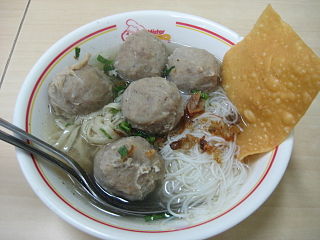
Bakso or baso is an Indonesian meatball, or a meat paste made from beef surimi. Its texture is similar to the Chinese beef ball, fish ball, or pork ball. The word bakso may refer to a single meatball or the complete dish of meatball soup. Mie bakso refers to bakso served with yellow noodles and rice vermicelli, while bakso kuah refers to bakso soup served without noodles.
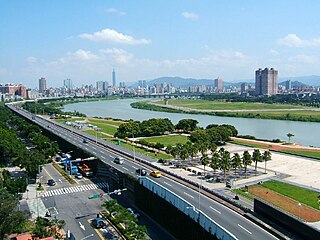
The Xindian River is a river in northern Taiwan. It flows through New Taipei and the capital Taipei for 82 kilometers (51 mi).
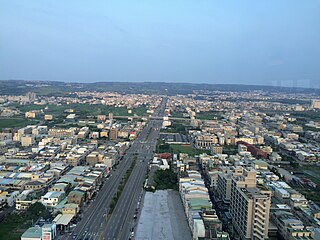
Shalu District is a suburban district in central Taichung City, Taiwan.

Tofu is a food prepared by coagulating soy milk and then pressing the resulting curds into solid white blocks of varying softness: silken, soft, firm, extra firm, or super firm. Tofu is also known as bean curd in English. Beyond these broad textural categories, there are many varieties of tofu. It has a subtle flavor, so it can be used in savory and sweet dishes. It is often seasoned or marinated to suit the dish and its flavors, and due to its spongy texture, it absorbs flavors well. It is a traditional component of East Asian and Southeast Asian cuisines, and has been consumed in China for over 2,000 years. In modern Western cooking, it is most often treated as a meat substitute.

Iron egg is a special version of soy egg, a snack from Taiwan. They are considered a delicacy and originated in the Tamsui District of New Taipei City.



















